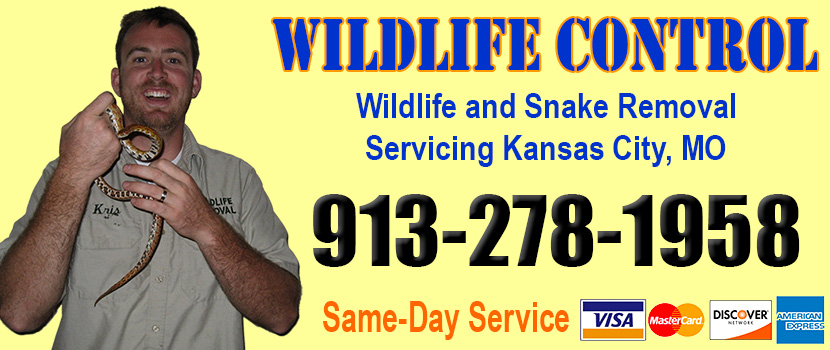
Welcome to kansascitysnakes.com! I am David, a snake enthusiast living in Kansas City, MO. Many people don't know that Kansas City is in fact full of snakes! You just need to know where to find them - they can often be shy and elusive. Some Missouri snake species are more common outside of the city limits, in different parts of Jackson County MO, but many types of snakes are indeed common in the more urban parts of Kansas City. This guide is meant to help educate you about the beautiful snakes of Kansas City, and to help you identify the most common snakes of Kansas City, as well as the venomous snakes of Kansas City that you should learn to recognize and avoid. If you want more detail, click here for my complete list of ALL snake species in Kansas City. Remember the following:
- Most snakes of Kansas City are harmless and don't want to encounter you
- Venomous snakes exist but are uncommon in Kansas City, Missouri
- Snakes eat rats and mice and are a valuable part of the Missouri ecosystem
- Never kill a snake - if you leave a snake alone, it will leave you alone.
Common Snake Species in Kansas City
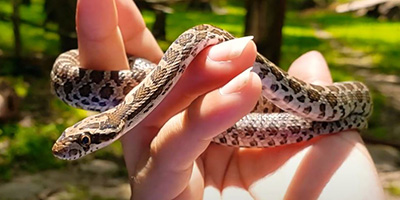 Great Plains Rat Snake:
This snake is in the same family as the corn snake but has a color pattern more suitable to the soils of Kansas to keep themselves effectively camouflaged.
Their colors and patterns, however, cause them to get misidentified as the massasauga rattlesnake or prairie kingsnake. One way to identify them apart is the dark line that goes from jaw to jaw through the eyes.
Great Plains Rat Snake:
This snake is in the same family as the corn snake but has a color pattern more suitable to the soils of Kansas to keep themselves effectively camouflaged.
Their colors and patterns, however, cause them to get misidentified as the massasauga rattlesnake or prairie kingsnake. One way to identify them apart is the dark line that goes from jaw to jaw through the eyes.
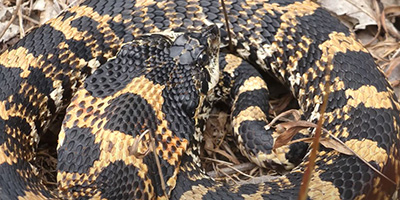 Eastern Hognose Snake:
The hognose snake, although varying in color, can be easily identified because they have upturned snouts.
A unique trait about them is their defensive behavior wherein they would spread their neck in a posture similar to that of a cobra’s. If they are picked up, they would vigorously spray musk.
They are strictly active during the day time and would even be seen crossing roads during the seasons of spring and fall.
Eastern Hognose Snake:
The hognose snake, although varying in color, can be easily identified because they have upturned snouts.
A unique trait about them is their defensive behavior wherein they would spread their neck in a posture similar to that of a cobra’s. If they are picked up, they would vigorously spray musk.
They are strictly active during the day time and would even be seen crossing roads during the seasons of spring and fall.
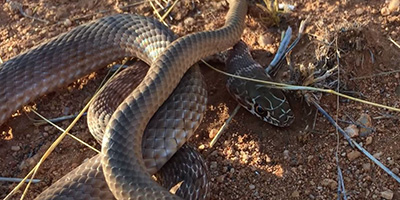 Coachwhip:
This snake species is known to be long and slender, but long for their size as they can reach over 8 ft. long.
Their color is a gradually fading black to tan or nearly white color going from their head to their tail. Although, this varies on where they are located.
A distinct feature coachwhips have is their large eyes as well as excellent vision. Commonly, they are seen during hot weather conditions.
Coachwhip:
This snake species is known to be long and slender, but long for their size as they can reach over 8 ft. long.
Their color is a gradually fading black to tan or nearly white color going from their head to their tail. Although, this varies on where they are located.
A distinct feature coachwhips have is their large eyes as well as excellent vision. Commonly, they are seen during hot weather conditions.
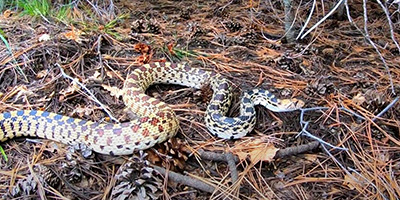 Gopher Snake:
Reaching up to 8 to 9 ft. in length, this species is the largest snake that can be found in the area. The gopher snake is commonly found in central and western prairies in Kansas.
They have light to dark brown or reddish blotches around their body -which are colored yellow, tan, or cream. They also have smaller blotches on their sides. A dark stripe is found in front of their eyes to the angle of the jaw. Their belly would often be cream or yellow with dark spots.
These snakes are commonly mistaken for a rattlesnake because of their behavior. When they detect a threat, they may become dangerous. However, they have no poisonous venom. Scared gopher snakes tend to flatten their heads, hiss loudly and rapidly shake their tail.
Gopher Snake:
Reaching up to 8 to 9 ft. in length, this species is the largest snake that can be found in the area. The gopher snake is commonly found in central and western prairies in Kansas.
They have light to dark brown or reddish blotches around their body -which are colored yellow, tan, or cream. They also have smaller blotches on their sides. A dark stripe is found in front of their eyes to the angle of the jaw. Their belly would often be cream or yellow with dark spots.
These snakes are commonly mistaken for a rattlesnake because of their behavior. When they detect a threat, they may become dangerous. However, they have no poisonous venom. Scared gopher snakes tend to flatten their heads, hiss loudly and rapidly shake their tail.
Venomous Snake Species in Kansas City
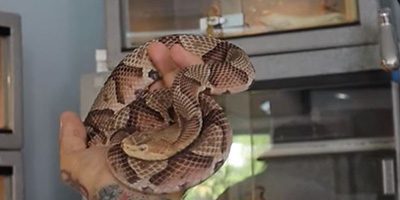 Osage Copperhead:
The Osage copperhead is a venomous species that usually resides in rocky forested hillsides or wetlands.
From their name, they have copper-colored heads and reddish-brown bodies with darker bands across their back. Being colored this way gives them the ability to camouflage among dead leaves.
The copperheads can locate their prey because of their heat-sensitive pits -which are located on each side of the head.
Osage Copperhead:
The Osage copperhead is a venomous species that usually resides in rocky forested hillsides or wetlands.
From their name, they have copper-colored heads and reddish-brown bodies with darker bands across their back. Being colored this way gives them the ability to camouflage among dead leaves.
The copperheads can locate their prey because of their heat-sensitive pits -which are located on each side of the head.
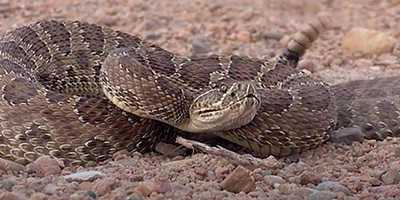 Prairie Rattlesnake :
Another venomous species found in the area is the prairie rattlesnake, which grows up to 57 inches long.
They are similar in appearance to the timber rattlesnake because of the pit on each side of their head, found slightly below the eye and nostril -which is also a key feature for the timber rattlesnake. However, they differ in pattern and color.
The prairie rattlesnake usually has light green to brown blotches on their back and dark bands on their tail. Their color is commonly greenish gray to light brown, while the blotches and tail bands would be similar in color. Their belly is either grayish, yellowish, or cream in color.
These snakes prefer living in rocky canyons and open prairies with small mammal burrows -particularly because they feed on smaller mammals such as lizards, rats, and pocket gophers.
Prairie Rattlesnake :
Another venomous species found in the area is the prairie rattlesnake, which grows up to 57 inches long.
They are similar in appearance to the timber rattlesnake because of the pit on each side of their head, found slightly below the eye and nostril -which is also a key feature for the timber rattlesnake. However, they differ in pattern and color.
The prairie rattlesnake usually has light green to brown blotches on their back and dark bands on their tail. Their color is commonly greenish gray to light brown, while the blotches and tail bands would be similar in color. Their belly is either grayish, yellowish, or cream in color.
These snakes prefer living in rocky canyons and open prairies with small mammal burrows -particularly because they feed on smaller mammals such as lizards, rats, and pocket gophers.
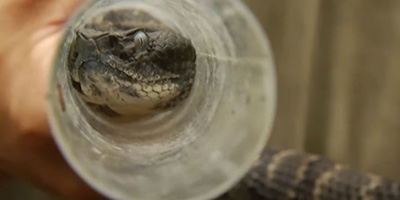 Timber Rattlesnake:
This venomous species is known as the largest rattlesnake in Kansas City with a length of up to 63 inches and weighing up to 5 pounds.
They have a pit on each side of their head in the area slightly below the eye and nostril. Their color varies from pinkish-gray to yellowish-brown with a red stripe running down the back. Their belly, however, is a grayish-white color.
These snakes are most active during the day in spring and fall. They are often located in rugged terrain along vegetated and rocky outcrops on forested hillsides. In the summer, they move to open meadows and hillsides.
Timber Rattlesnake:
This venomous species is known as the largest rattlesnake in Kansas City with a length of up to 63 inches and weighing up to 5 pounds.
They have a pit on each side of their head in the area slightly below the eye and nostril. Their color varies from pinkish-gray to yellowish-brown with a red stripe running down the back. Their belly, however, is a grayish-white color.
These snakes are most active during the day in spring and fall. They are often located in rugged terrain along vegetated and rocky outcrops on forested hillsides. In the summer, they move to open meadows and hillsides.
If you're unsure, you can email me a photo of the snake at info@kansascitysnakes.com and I will email you back with the snake's species. If you found a snake skin, read my Found a Skin? page, and you can email me a photo of the skin, and I'll identify the snake for you. If you need professional Kansas City snake removal help, click my Get Help page, or see the below website sponsor I found, who provides that service.
Remember, the term is not poisonous snakes of Kansas City, it's venomous snakes of Kansas City. Poison is generally something you eat, and venom is injected into you. That said, dangerous snakes are very rare in Kansas City. The few venomous snakes of Jackson County are rarely seen. But they are commonly misidentified, so learn about all the snake species of Kansas City in order to correctly identify them. These snakes are usually also found in the surrounding towns of Kansas City, North Kansas City, Independence, Overland Park, Shawnee, Roeland Park, Mission, Leawood, Lenxa, Lake Quivira, Edwardsville, Piper, Riverside, Gladstone, Claycomo, Pleasant Valley, Randolph, Brimingham, Platte Woods, Sugar Creek, Blue Summit, and the surrounding areas.
Read our article about:
Your Complete Guide on Copperhead Snakes
kansascitysnakes.com domain and hosting costs made possible by the generous support of this sponsor:
